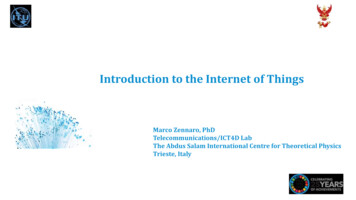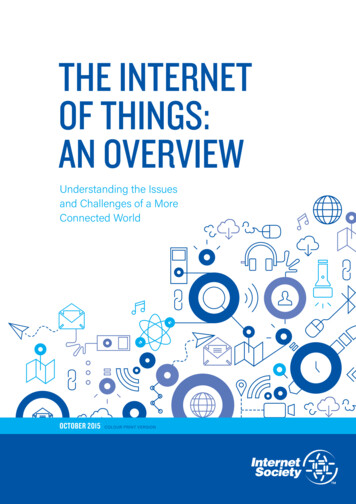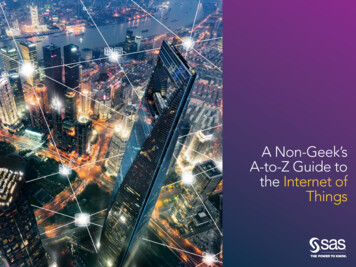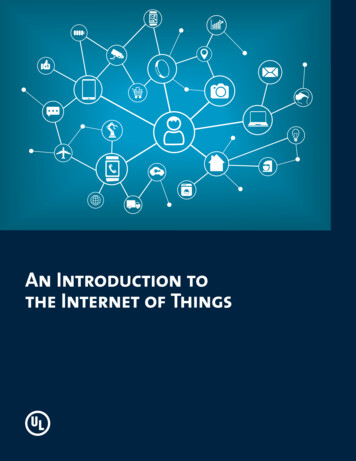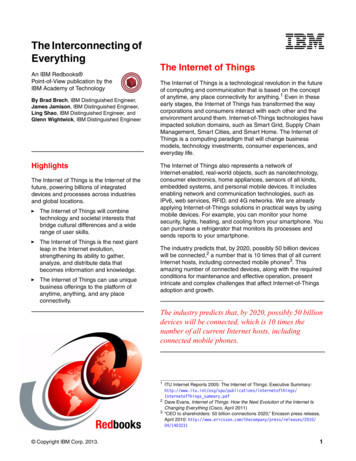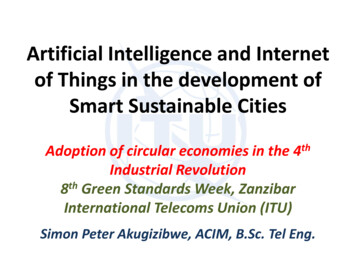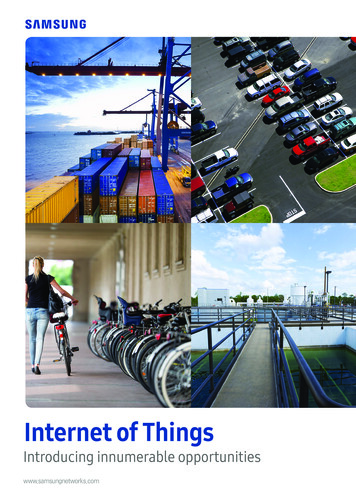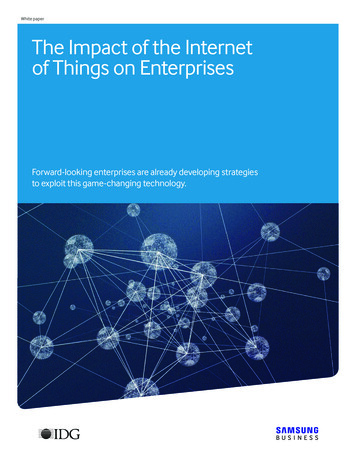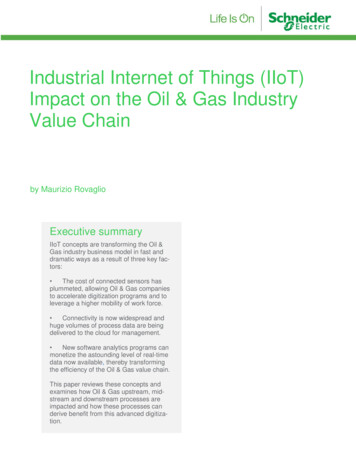
Transcription
Industrial Internet of Things (IIoT)Impact on the Oil & Gas IndustryValue Chainby Maurizio RovaglioExecutive summaryIIoT concepts are transforming the Oil &Gas industry business model in fast anddramatic ways as a result of three key factors: The cost of connected sensors hasplummeted, allowing Oil & Gas companiesto accelerate digitization programs and toleverage a higher mobility of work force. Connectivity is now widespread andhuge volumes of process data are beingdelivered to the cloud for management. New software analytics programs canmonetize the astounding level of real-timedata now available, thereby transformingthe efficiency of the Oil & Gas value chain.This paper reviews these concepts andexamines how Oil & Gas upstream, midstream and downstream processes areimpacted and how these processes canderive benefit from this advanced digitization.
Schneider Electric White Paper Rev 0Introduction2Most companies within the Oil & Gas industry have been able to withstand sharpdrops in oil prices thanks in part to streamlining within their organizations andsimplification of processes across their enterprises. The significant drop in oilprices— below US 40 per barrel at the end of 2015, down more than 60% fromtheir high in the summer of 2014 1—reflects a combination of oversupply and weakglobal demand along with general global economic concerns.How Oil & Gas executives respond to these changes and to other trends (e.g.,growth in popularity of renewable energy) will determine both the short and longterm survival of their organizations. Most executives are beginning to think and actdifferently than they have in the past. They are reassessing the purpose andstrategic direction of their companies and are finding new ways to make theirorganizations profitable.Low prices are forcing powerful innovations in the way oil & gas is being developedand produced. Recent developments in the area of the Industrial Internet of Things(IIoT) are facilitating changes that can result in the reduction of unit costs of oilproduction and ultimately higher returns on capital employed. The profound technology changes that are just beginning to manifest themselves, will result in an Oil &Gas industry that will be stronger, leaner, and more durable.Figure 1IIoT will result in thereductions of unit cost ofoil productionThe backbone of the transformative IIoT trend is the linkage of connectivity, cloud,and analytics technologies to simplify process automation. As pressure on oil pricescontinues, the demand for digitized upstream, midstream and downstream applications will grow. Opportunities to link multiple platforms operated remotely from asingle onshore center or to deploy remote monitoring for onshore and offshoreoperations can dramatically reduce the need for physical on-site inspections.Consider, for example, how the use of drone technology to inspect pipelines or todiscover new deposits in remote locations changes the equation.Multiple flying drones called “aerial data collection bots” examine job sites during oilexploration. While performing their tasks, these drones generate large quantities ofdata in the form of high definition video. Legacy methods for performing this type ofwork involves manned helicopters with cameramen for shooting surveillance video.Self-piloted drones can photograph job sites 24 hours a day providing site managersan up-to-the-minute view of how their resources are deployed. A local edge compu1Boston Commons High Tech Network, “World Oil Market Demand & Supply Trends”, July 2016How the Industrial Internet of Things (IIoT) Impacts the Oil & Gas Industry Value Chain
Schneider Electric White Paper Rev 03ting site allows the drones to transmit the data in real time and receive instructionsin a timely fashion.On business growth“It would be sad if during thisperiod of the low businessvolume that (oil companies)did not make the necessarychanges to deliver betterresults when the businessenvironment improves.”- Senior Advisor, Large USbased international Oil and GasCompanyIndustry outlookSuch a digital transformation framework empowers traditional refinery managers tore-invent their operations. By exploiting disruptive digital technologies, they canoptimize CAPEX and/or OPEX while providing technologies, infrastructures andservices that enable the transition towards a more sustainable business. Modernization of assets, volatility of market demand and energy efficiency are three disruptiveforces that refineries will need to address in order to convert shifting businessclimates into opportunities.The deployment of IIoT solutions translates into increased intelligence throughoutthe process workflow, more accurate and granular data collection and analytics, andhigher levels of automated control and decision making. Deployment of thesetechnologies can be viewed as disruptive to the traditional way of conductin gbusiness. In the end, however, IIoT approaches will help companies establish newbenchmarks in efficiency (including energy efficiency), and productivity whilefostering collaboration.In 2015 the energy market spent 7 Billion on IoT solutions. Projected compoundannual growth rate of this spending is expected to climb to 22 Billion in 2020. 2McKinsey Global Institute research also projects a period of aggressive growth,estimating that the impact of the Internet of Things on the global economy might beas high as 6.2 trillion by 2025.3Oil & Gas executives surveyed in June 2016 by Schneider Electric as part of itsrecurrent strategic research offered numerous perspectives regarding businessgrowth, digital transformation and corporate culture transition. Most agreed that IIoTwill be an important source of growth for them over the next several years—as willbe the trends in wireless computing and big data. At the same time, the corporateleaders polled admitted that they lack a clear perspective on the concrete IIoTbusiness opportunities given the breadth of applications being developed, an d thefact that the trend is still nascent.Figure 2Industry growth forecastssurrounding the expansion of IoT, Big Data, andCloud Services2Markets & Markets, “Internet of Things Technology Market by Hardware, Platform, Software Solutions,and Services, Application, and Geography - Forecast to 2022”, 20163Bauer, Harald, Patel, Mark, and Veira, Jan, McKinsey & Company, “The Internet of Things: Sizing upthe opportunity”, December, 2014How the Industrial Internet of Things (IIoT) Impacts the Oil & Gas Industry Value Chain
Schneider Electric White Paper Rev 04Below is a summary of some of the findings that resulted from the survey administered to the Oil & Gas executives: Cyber security was identified as the #1 potential obstacle when consideringIIoT initiatives CAPEX savings were identified as the #1 motivator for initiating IIoT projects 62% of survey participants expressed a willingness to work with companieslike Schneider Electric for the purpose of launching IIoT-related Software as aService (SaaS) pilots 85% of survey participants indicated that they were looking to deploy SaaSsolutions within next 1 to 3 yearsThese perspectives point to a need for Oil & Gas companies to adjust currentbusiness models. They will need to support these changes through the exploitationof new, more affordable IIoT technologies to deliver performance improvements.All participants also expressed a high degree of interest in expanding the use of “asa service” business models for both increasing productivity and lowering costs.Figure 3 below illustrates the solution preferences of the workshop participants.Figure 3Software as a Service(SaaS) solutions canapply themselves inmultiple Oil & Gas valuechain environmentsSaaS offerings are an outgrowth of the convergence of Information Technologies(IT) and Operational Technologies (OT). Flexibility and a “pay as you use” approach ,which has made such offerings attractive across multiple industries , are nowinfluencing cost control initiatives across Oil & Gas industry environments.The SaaS business model presents both advantages and disadvantages for Oil &Gas company stakeholders.Below are listed some of the more significant advantages: Time to deployment - SaaS software solutions can be implemented in a matter of weeks rather than monthsHow the Industrial Internet of Things (IIoT) Impacts the Oil & Gas Industry Value Chain
Schneider Electric White Paper Rev 05 Fewer internal responsibilities - Cloud service providers are responsible formaintaining the software, upgrading the hardware and supplying enhancements through upgrades. Scalable and Flexible - Cloud technology can be scaled up or down quickly toreflect changing customer requirements. Customers are only charged for whatthey use, without having to shoulder up-front deployment costs. Thus start-upcosts are lower than similar on-premises solutions. Software integration ofcloud and existing home grown applications is also made easier. Anywhere Access - Cloud technology only requires a browser and internetaccess to connect. This facilitates mobile access, remote work and collaborative sharing of information.On cultural change“People employed within oil& gas enterprises need tochange their workingpractice, and will be in thefuture assisted with mobiledevices and apps. Oursystems will increasingly usecloud technologies, inparticular for our distributionbusiness; but also potentiallyfor upstream and downstream business. Critical datawill remain the property ofeach company but many willexperiment with the Big Dataapproach.”- Chief Digital Officer, LargeEuropean-based internationalOil & Gas company Resilience - The IT infrastructure and the data generated is stored at theCloud provider data center site. In the event of a disaster (i.e., should the datacenter go down for any reason), the data is backed up on a regular basis andcan be easily accessed from another physical or virtual location.The disadvantages of the SaaS model include the following: Security concerns - Access management and the privacy of sensitive information are still top of mind issues when placing company data into the handsof third parties. However, surveys have shown that these concerns are decreasing every year. Advancements in encryption techniques and other technological improvements are reducing the levels of concern so that cloud datais being considered at least as secure as traditional proprietary data (i.e., service providers are motivated to provide robust security in order to remain inbusiness). Compliance – Individual countries and industries have differing regulations inrespect to where data is stored. Businesses need to ensure compliance withthese regulations when implementing SaaS solutions.In order to execute against the changing business challenges of budgetary constraints, organizational barriers, cybersecurity concerns, poor process efficiency andhigh costs, the core IIoT-driven contributions supported by vendors like SchneiderElectric include: Business process efficiency (higher productivity and profitability) High asset availability and performance (predictive and condition basedmaintenance) Risk mitigation and safety (embedding safety into product designs) Enablement of faster time-to-market (securing both centralized and edge applications) Sustainable growth (low CO 2 emissions products and systems).Crossing theIIoT thresholdIIoT technologies are introducing new possibilities for extracting more value fromexisting systems. These OT systems can now be converged with popular, standardized IT systems. In addition, large-scale analytics techniques derived from nonindustrial applications such as finance, workforce management, and healthcare, arebeing applied to Oil & Gas industry scenarios and are creating new ways for Oil &Gas operations to extract more profit.The ability to exploit IIoT benefits and the associated higher degrees of operationalintelligence will rely on three important technology attributes:How the Industrial Internet of Things (IIoT) Impacts the Oil & Gas Industry Value Chain
Schneider Electric White Paper Rev 06 Connectivity - Collection of data at the local level, and delivery of much higherquantities of data to the cloud Cloud - Inexpensive but safe and reliable storage and management of thatdata Analytics - Conversion of that data into real-time information that drives quickbut accurate business decisionsBig Data and analytics may be new to some industries, but for many years the Oil &Gas industry has processed large quantities of data in order to drive decisions. As aresult of the experience of determining what lies below the earth's surface and howto bring it out, energy companies have invested in seismic software, visualizationtools and other digital technologies. Now, the rise of pervasive computing devices ,affordable sensors that collect and transmit data, new analytic tools and advancedcloud storage capabilities are opening new doors. (Average selling prices for alltypes of semiconductor sensors are forecast to fall by a compound annual growthrate of -5% in the next five years, which is double the rate of decline for the periodextending from 2009 to 2014.4 This presents a whole new universe of opportunitythat will make its influence felt from exploration to production and on downstreamactivities as well.REDEFINED.Innovation At Every LevelEcoStruxure.ioEnd to End CybersecurityIIoT will influence theway Oil & Gas companies deploy connectivity,cloud and analyticsCloud and/or On PremiseOnshoreFigure iesIndustriesPetrochemicalSupply ChainApps, Analytics & ServicesEdge ControlConnected ProductsIIoT is also playing an important role in revolutionizing the way new workers arebeing trained and the way operators are improving the safety and efficiency ofoperations. For years now the Oil & Gas industry has struggled with the challenge ofretirement-age workers who are leaving and not being replaced. As they depart (orare being pushed out during this crisis) they take their institutional knowledge withthem and their organizations are left behind scrambling to fill the gap.Consider how advancements in the areas of virtual and augmented reality areimpacting this issue. The ability to gather all of this data at an affordable cost meansthat information can be applied to simulation of real-life situations. Simulation isbecoming a key tool to design processes, optimize operations, and train operators.With new technologies such as immersive virtual reality, Oil & Gas industry operators are offered a safe environment where they can mimic all possible situationswhile reducing business interruption costs. Simulation software enables training forall kinds of applications and can be delivered in a 3-D, photorealistic, and interactiveenvironment.4IC Insights, “O-S-D Report—A Market Analysis and Forecast for Optoelectronics, Sensors/Actuators,and Discretes”, 2015How the Industrial Internet of Things (IIoT) Impacts the Oil & Gas Industry Value Chain
Schneider Electric White Paper Rev 07From online learning modules around individual equipment and small systems tocomplete instructor-led virtual-reality environments of an entire upstream, midstreamor downstream operation, full-scope simulators are now available. Common techniques include: photo scanning surveys, laser scanning surveys, and existing 3 -Dcomputer-aided design models; all of which engage virtual reality to create realworld situations for operators. Training and simulation augment the situationalawareness of operators so they can prevent production or output problems byanticipating contingencies and preparing for remedial actions.Most of these solutions can run today from a laptop, a tablet, or even a cell phone.Figure 5Augmented reality isone example of aproductivity tool that isfacilitated through thegrowth of IIoT technologies.The look of a complex spreadsheet need no longer make new operators feelqueasy. Cumbersome spreadsheets are now converted into powerful, web-based,interactive, user-friendly platforms. At an Oil & Gas distribution center, a 3D view ofthe pipeline network lets prospective operators see where a leak could happen, ifservice isn't performed within the next 3 months. In operations across the globe,Operator Training Simulators (OTS) are utilized as advanced training tools thatprovide young operators the skills they need to run a process or plant. Operatorslearn how to manage a refinery in a safe virtual control room that simulates responses to different scenarios. This provides trainees the opportunity to learn how toreact appropriately when a similar situation occurs in real life.Although user interfaces may be simple and intuitive, they mask some complexprocesses that represent the fundamental core of utility or manufacturing operations.For example, a Schneider Electric tool called SimSci Dynsim is a rigorous processdynamics simulation platform that predicts the time dependent future behavior ofindustrial processes.The business value that is generated includes lower capital costs and improvedplant design while giving the organization the opportunity of "getting it right the firsttime". These solutions include design checkout control systems for ProgrammableLogic Controllers (PLCs), Emergency Shutdown Systems (ESDs) and DistributedControl Systems (DCSs), all working together to optimize the production process.In essence, the disruptive impact of IIoT can be attributed to three main influencers: The trend towards accelerated use of mobile Human Machine Interface (HMI)technologies via smartphones, tablets and wearables, combined with IPHow the Industrial Internet of Things (IIoT) Impacts the Oil & Gas Industry Value Chain
Schneider Electric White Paper Rev 08access to data and information (and the associated analytics and augmentedreality). Portable wireless devices are expanding their capabilities and are improving the operator experience. This makes the "augmented" operator moreproductive. Affordable access to Cloud technology, which requires only a browser andinternet access to connect. This makes mobile access, working from remotesites, and the sharing of information easier than ever. The vast diversity of new data sources (from sensors to marketplace data) andenabling analytics can now be applied to new wide areas of the Oil & Gas value chain.The following sections address the core pillars of IIoT deployment: connectivity,cloud, and analytics.Gathering andmoving data(connectivity)The Oil & Gas industry spent 3.5 Billion in 2015 on big data-related projects 5, withprojected annual growth of 31% by 2020. 6 What will drive this growth? Oil producers can capture more detailed data in real time at lower costs and drive profit frompreviously inaccessible areas. For example, by pairing real-time down-hole drillingdata with production data of nearby wells, stakeholders can adapt new drillingstrategies, especially in unconventional fields.As OT systems (OT representing a vast collection of physical infrastructure systemssuch as power and control, heating, cooling and ventilation systems ) are now beingequipped with either built-in connectivity intelligence, or field upgraded connectivity,much more operational performance data is being forwarded to the cloud andanalyzed. This is forming a much more pervasive “sensing” layer for data gathering .On digitaltransformation“Digital emphasis is now onthe process control network(PCN) and higher levelplanning tools (e.g. pipelinemanagement - controllinginput gas or oil field production from multi-partyownership on the basis ofcommercial agreements).Cyber-security continues tobe high priority. It isincreasingly a challenge tofind resources that haveappropriate IT and processcontrol systems knowledge.”– I&P lead engineer, LargeEuropean-based internationalOil & Gas companyThe technologies included in this sensing layer are fundamentally the same IoTtechnologies used in t
In 2015 the energy market spent 7 Billion on IoT solutions. Projected compound annual growth rate of this spending is expected to climb to 22 2Billion in 2020. McKinsey Global Institute research also projects a period of aggressive growth, estimating that the impact




